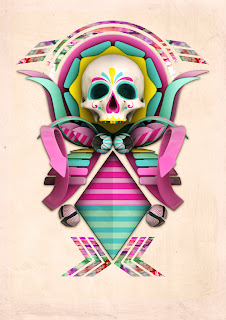It happens to the best of teachers.
Since I am using this blog to reflect on my teaching practice, I think it is important to share these experiences as well as all the success stories that take place in my classroom. This will be the first, in a (hopefully) short series of posts that deal with failed lessons or parts of lessons and how I changed them to make sure students don't have a frustrating learning experience with me.
Last Wednesday I had a project planned that introduced 1st graders to the work of British designer Lo Cole. I loved the translucent overlapping that he has going on in the above image and I wanted the kids to create that same effect. To create the birds, students would use tissue paper. To be more specific, they would cut the bird shapes out of tissue paper. This is where things went awry. The kids had such a hard time cutting out the shapes from the flimsy paper. Birds were tearing left and right. To make it even more complicated, I had the kids fold the paper so they could cut out 2 birds at once. They had a hard time keeping the 2 layers together as they cut, so a number of students ended up with 3 raggedy birds instead of 6.
I had done a sample myself before doing it with the students, and it didn't occur to me that they would have so many problems.
After I met with that class, I decided to switch to using tempera paint and stencils. Students would use primary colors to paint the birds and wherever they overlapped, they would mix secondary colors to fill those new shapes. The results were much better and there were very few frustrated students.
I'm going to reschedule that first class, so they can have an another opportunity to feel successful in art making.
In hindsight, I could have had students draw the birds on the big sheet and tear small bits of tissue to fill those shapes. Students could use modge podge to adhere the pieces t the paper with a brush.
Lesson learned- do not have students tear complicated shapes out of tissue paper.











